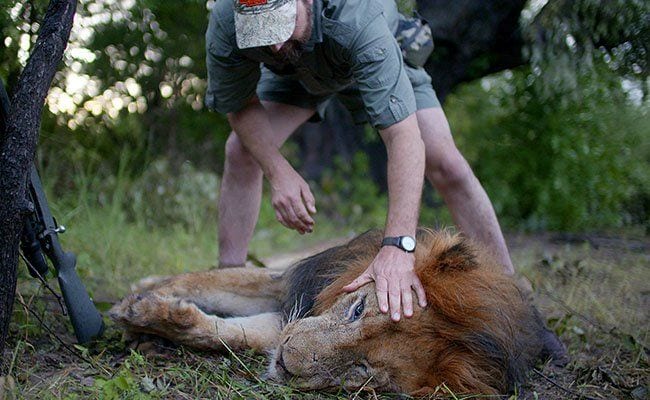
In Trophy, an African Safari expedition goes awry when a conservationist hunter, Philip Glass, rashly shoots a baby elephant. The documentary’s directors, Shaul Schwarz and Christina Clusiau, painstakingly emphasize the visually harrowing nature of the botched hunt through a slow, rising aerial shot over the deceased animal.
As it turns out, however, there are several other reasons to lament this death. Glass and the hunting party are disappointed they didn’t kill an older elephant, as younger ones can still breed for conservationist purposes. Locals have their own practical complaints: a baby elephant doesn’t yield enough meat, and larger elephants are a greater threat to livestock.
This complex episode, which is one of several in Trophy, highlights the film’s major cinematic accomplishment: it pits emotionally unsettling images against a sophisticated blend of practical justifications which compel a more mature outlook on the correlation between big game hunting and wildlife conservationism.
Trophy explores this seemingly paradoxical relationship by observing a rich array of participants in what can be aptly called the wildlife industrial complex. Hunters, ranchers, anti-poaching professionals, and animal rights activists, to name a few, are all key parties in this complex web. Each player is given an even treatment through Schwarz and Clusiau’s assured and participatory camerawork, which chronicles their practices (many over beautifully shot South African wilderness) to the desired affect of deep consideration rather than judgment.
While Trophy serves as an effective road map of arguments pertaining to the wildlife extinction crisis (the world has now lost 60 percent of its wildlife population), the film is most edifying as a character study. Sadly, human beings will control the fate of wildlife. Accordingly, Trophy’s exploration of human motivation doubles as a foray into the future of wildlife preservation.
Glass makes for perhaps the film’s most interesting study. Certainly, his stated viewpoints alone reflect a crass big game hunter who has a few one-sided arguments against evolutionist theory and “infantile” animal rights activists. However, Schwarz and Clusiau’s extensive on-the-ground coverage of Glass during his hunts reveal a deeper, more reverential man. Glass’s several day long search over the open African terrain for elder prey is more deeply considered than a hunt for a mere adrenaline rush. In one compelling scene, a shadowy campfire shot captures Glass ruminating on his existential relationship to the hunt. Here, Trophy effectively suggests that while game hunters will always be present in the world, perhaps game-hunting and preservationists could co-exist more harmoniously if game hunters treated the hunt with Glass’s same level of consideration.
At the opposite end of the debate is animals rights activist John Hume, another fascinating character. Hume is a gruff proponent of the realpolitik “pay to stay” philosophy, which posits that for wildlife to survive, it must have value on the open market. But he is also a child at heart who, if he could, would save every rhino on the planet.
Hume has invested nearly $50 million into his rhino farm in South Africa. On the farm, Hume raises his “magical creatures”… and… chainsaws their horns every couple of years. Schwarz and Clusiau effectively encourage exploration into this uneasy co-existence between seemingly cruel behavior and conservationist ideals. A long, close-up shot of a chainsaw slicing through the horn, particles flying through the air, is cringeworthy if not stomach turning. At the same time, Hume unapologetically explains that by collecting lucrative Rhino horns to be sold for several million dollars, he can use the money to breed the animal out of extinction on his farm, and protect them from poachers who will likely do far worse to the nearly extinct animal.
Trophy realistically acknowledges that the ultimate governing dynamic of the “pay to stay” market are the several thousands of game-hunters and exotic animal shoppers found at flamboyant trophy hunting auctions, where salesman and auctioneers profit off exotic animal fetishes. In perhaps the film’s most harrowing scene, a rowdy group of amateur hunters armed with beer cans, rifles, and Instagram accounts roam around a gated hunting resort. They shoot animals at close range, exchange broisms, and build their Instagram feed with photos of them posing next to dead trophy animals.
Which is to suggest that the demand-side of the wildlife market is even more brutal and dangerous than the supply side. In an interview with Adam Roberts from the Born Free Foundation, Roberts argues that the “Rooseveltian” romanticization of the hunt as a character-building endeavor is nonexistent. Safari tourists want a quick, fast food serving of trophy animals over the course of hours, with some social media posts to follow. If these vacation hunters continue to escalate in numbers, does “pay to stay” quickly erode to simply pay to kill?
Certainly, Trophy advances arguments about these dangers. However, because Schwartz and Clusiau are more acutely focused on thoughtful high level players and suppliers rather than on seemingly more reckless demand-side of the equation, a sense of urgency that “pay to stay” may be more unhinged than meets the eye is partially sacrificed.
Accordingly, if one considers the goal of a documentary to galvanize a progressive movement clearly on the “right” side of things, Trophy may fall short. But in deliberately refusing to push a single agenda, Trophy maturely acknowledges the wildlife ecosystem — and for that matter, human motivation – as a delicate if not unsettling balance of several factors. Each must be addressed with deep rumination and an open mind, which is the very least humans can offer to the animals.

